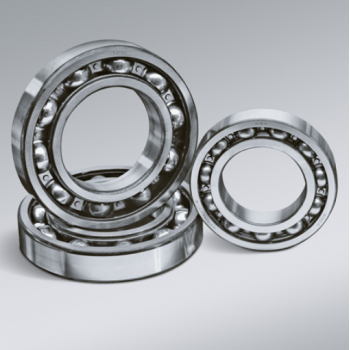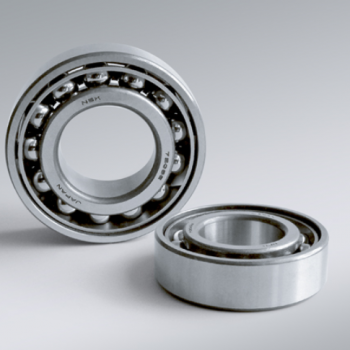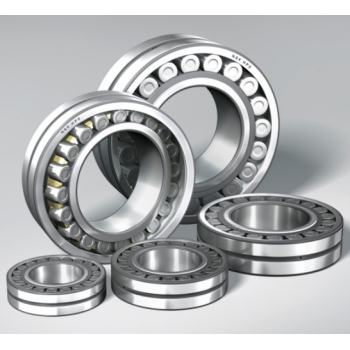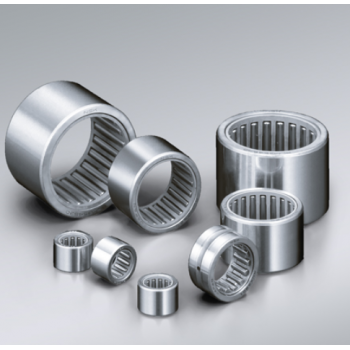NSK Bearing

NSK has two core business segments─the Industrial Machinery Business (industrial machinery bearings, precision machinery and parts) and the Automotive Products Business (automotive bearings, automotive components).
NSK aims to focus on the needs of each customer and market by further accelerating its business-based management system, in which sales, production, and technology functions are operated under one umbrella by the
respective business division headquarters, which also hold responsibility for advancing growth strategy and profitability improvement initiatives.
NSK has engaged in technological challenges for many years, working with customers around the world to develop effective solutions. We have developed high performance products through strengthening our global R&D
focus. We continue to create top of the line products that utilize the core technologies of lubrication, materials, and analytical techniques to respond to field requirements.

Ball Bearings are very versatile. They can be designed to accommodate radial loads, axial loads and combined radial/axial loads in a wide range of operating speeds. These characteristics combined with relative cost and compactness of design result in their universal appeal in the industry. Ball bearings are widely used in electric motors, gear reducers, and pumps. Roller Bearing manufactures large diameter ball bearings from 8” bore and above, servicing heavy equipment such as large motors, extruders, pumps, as well as specialty applications in steel and aluminum processing, oil and gas drilling, and mining applications. We can manufacture ISO standard designs or design and manufacture a large diameter ball bearing that meets your specific needs.
Single-Row Deep Groove Ball Bearings
Pressed Steel Cages
Single-row deep groove ball bearings are the most common type of rolling bearings. Their use is very widespread.
In addition to open type bearings, these bearings often have steel shields or rubber seals installed on one or both sides and are prelubricated with grease. Also, snap rings are sometimes used on the periphery. As to cages, pressed steel ones are the most common.
For big deep groove ball bearings, machined brass cages are used.
Machined cages are also used for high speed applications.
Extra Small Ball Bearings and Miniature Ball Bearings
Miniature and instrument ball bearings can be divided into two basic types, deep groove and angular contact. The first (deep groove) can be further divided into the following five classes depending on their design details:
Flanged outer ring
Expanded type in which one ring has a radial thickness that is larger than normal compared with the bearing width.
Thin section type in which both rings are extra thin in the radial direction. They can also be classified as: open, shielded, or sealed.
Maximum-Type Ball Bearings
Maximum-Type ball Bearings contain a larger number of balls than normal deep groove ball bearings because of filling slots in the inner and outer rings. Because of their filling slots, they are not suitable for applications with high axial loads. BL2 and BL3 types of bearings have boundary dimensions equal to those of single-row deep groove ball bearings of Series 62 and 63 respectively. Besides the open type, ZZ type shielded bearings are also available. When using these bearings, it is important for the filling slot in the outer ring to be outside of the loaded zone as much as possible. Their cages are pressed steel.
Magneto Bearings
The inner groove of magneto bearings is a little shallower than that of deep groove bearings. Since the outer ring has a shoulder on only one side, the outer ring may be removed. This is often advantageous for mounting. In general, two such bearings are used in duplex pairs. Magneto bearings are small bearings with a bore diameter of 4 to 20 mm and are mainly used for small magnetos, gyroscopes, instruments, etc. Pressed brass cages are generally used.

Single-Row Angular Contact Ball Bearings (Pressed Steel Cages & Machined Brass Cages)
Since these bearings have a contact angle, they can sustain significant axial loads in one direction together with radial loads. Because of their design, when a radial load is applied, an axial force component is produced; therefore, two opposed bearings or a combination of more than two must be used.
Since the rigidity of single-row angular contact ball bearings can be increased by preloading, they are often used in the main spindles of machine tools, for which high running accuracy is required.
Usually, the cages for angular contact ball bearings with a contact angle of 30° (Symbol A) or 40° (Symbol B) are in accordance with Table 1, but depending on the application, machined synthetic resin cages or molded polyamide resin cages are also used. The basic load ratings given in the bearing tables are based on the cage classification listed in Table 1.
Matched Angular Contact Ball Bearings
The types and features of matched angular Contact Ball bearings are shown in Table 2
Double-Row Angular Contact Ball Bearings
This is basically a back-to-back mounting of two single-row angular contact ball bearings, but their inner and outer rings are each integrated into one. Axial loads in both directions can be sustained, and the capacity to sustain moments is good. This type is used as fixed-end bearings.
Their cages are pressed steel.
Four-Point Contact Ball Bearings
The inner ring is split radially into two pieces. Their design allows one bearing to sustain significant axial loads in either direction.
The contact angle is 35°, so the axial load capacity is high. This type is suitable for carrying pure axial loads or combined loads where the axial loads are high.
The cages are made of machined brass.

Cylindrical Roller Bearings
In bearings of this type, the cylindrical rollers are in linear contact with the raceways. They have a high radial load capacity and are suitable for high speeds.
There are different types designated as NU, NJ, NUP, N, NF (for single-row bearings), NNU, and NN (for double-row bearings depending on the design or absence of side ribs).
The outer and inner rings of all types are separable.
Some cylindrical roller bearings have no ribs on either the inner or outer ring, so the rings can move axially relative to each other. These can be used as free-end bearings. Cylindrical roller bearings,
in which either the inner or outer rings has two ribs and the other ring has one, are capable of taking some axial load in one direction Double-row cylindrical roller bearings have high radial rigidity and are used primarily for
precision machine tools.
Pressed steel or machined brass cages are generally used, but sometimes molded polyamide cages are also used.
Tapered Roller Bearings
Bearings of this type use conical rollers guided by a back-face rib on the cone. These bearings are capable of taking high radial loads and axial loads in one direction.
In the HR series, the rollers are increased in both size and number giving it an even higher load capacity. They are generally mounted in pairs in a manner similar to single-row angular contact ball bearings. In this case,
the proper internal clearance can be obtained by adjusting the axial distance between the cones or cups of the two opposed bearings. Since they are separable, the cone assemblies and cups can be mounted independently.
Depending upon the contact angle, tapered roller bearings are divided into three types; normal angle, medium angle, and steep angle.
Double-row and four-row tapered roller bearings are also available. Pressed steel cages are generally used.
Spherical Roller Bearings
Shown in the figures, types EA, C, CD, CA, which are designed for high load capacity, are available. Types EA, C, and CD have pressed steel cages; and type CA has machined brass cages. Type EA has especially high load capacity, features low torque, and has a high-strength cage.
An oil groove and holes are provided in the outer ring to supply lubricant and the bearing numbers are suffixed with E4.
To use bearings with oil grooves and holes, it is recommended to provide an oil groove in the housing bore, since the depth of the groove in the bearing is limited.
Thrust Cylindrical Roller Bearings
These are thrust bearings containing cylindrical rollers. They can sustain only axial loads, but they are suitable for heavy loads and have high axial rigidity.
The cages are machined brass.
Thrust Spherical Roller Bearings
These are thrust bearings containing convex rollers. They have a self-aligning capability and are free of any influence of mounting error or shaft deflection. Besides the original type, the E type with pressed cages for high load capacity is also available. Their bearing numbers are suffixed by E.
For horizontal shaft or high speed application, machined brass cages are recommended. For details, contact NSK. Since there are several places where lubrication is difficult, such as the area between the roller heads and inner ring rib, the sliding surfaces between cage and guide sleeve, etc., oil lubrication should be used even at low speed. The cages in the original type are machined brass.

Cage & Needle Roller Assemblies
NSK cage & Needle roller assemblies consist of a complement of needle rollers held in place by a cage. Their unitized design makes for easy handling and installation. With no inner or outer ring, the low cross-section provides maximum load-carrying capability within the smallest envelope.
Properly lubricated, they can operate at high speeds thanks to the unique cage, which guides the rollers precisely. The controlled contour rollers in cage & Needle roller assemblies have an optimum profile which reduces end stresses, allows operation under moderate misalignment and prolongs bearing life.
Drawn Cup Needle Roller Bearings
NSK drawn cup needle roller bearings (with a cage and full complement of rollers) have a unique outer ring structure. They have the following features: the thinnest outer ring among rolling bearings, high load capacity, high maximum permissive load owing to the use of carefully selected special alloy steel plates, a surface-hardened cage with high resistance to wear, high limiting speed, and ease of mounting.
Solid Needle Roller Bearings
Solid needle roller bearings are high-accuracy bearings with maximum load capacity within a limited space for various operating conditions. Made of carefully selected vacuum-degassed bearing steel or carburizing steel, the raceway rings are finished with accurate grinding after heat treatment. The outer rings have strong integrated ribs and contain high-accuracy rollers that have the proper crowning finish. Lightweight and extremely strong, the cage guides the rollers accurately and smoothly.
Thrust Needle Roller Bearings
Thrust needle bearings type comes in metric and inch designs. The cage & Needle roller assembly for the thrust needle bearing is a cage that has two pieces joined together, to which surface hardening is applied after the precision press processing of a steel plate, and in which high accuracy rollers are incorporated, in order to achieve rigidity and wear resistance. Many rollers are retained securely in the cage, taking large axial load, and yet rotating smoothly. Mounting space is so small that it is easy to replace a conventional sliding thrust washer. Different thicknesses of various types of thrust raceway washers are available in this cage & Needle roller assembly, which allows selection of the appropriate thickness suited for bearing peripheral mounting conditions.
Cam Followers
Cam followers, which are equipped with a thick-wall outer ring, crowned rollers, and a stud with a hardened raceway surface, are especially tough and can sustain shock loads.
Roller Followers
The roller follower with a thick-wall outer ring and crowned roller has a large load capacity which enables it to carry shock loads. Handling is easy since it it non-separating and applications such as track rollers, cams and rocker arms are wide.

















